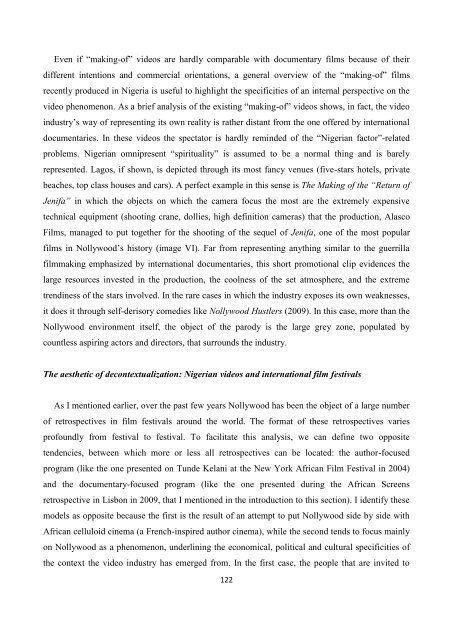Create successful ePaper yourself
Turn your PDF publications into a flip-book with our unique Google optimized e-Paper software.
Even if “making-of” videos are hardly comparable with documentary films because of theirdifferent intentions and commercial orientations, a general overview of the “making-of” filmsrecently produced in Nigeria is useful to highlight the specificities of an internal perspective on thevideo phenomenon. As a brief analysis of the existing “making-of” videos shows, in fact, the videoindustry’s way of representing its own reality is rather distant from the one offered by internationaldocumentaries. In these videos the spectator is hardly reminded of the “Nigerian factor”-relatedproblems. Nigerian omnipresent “spirituality” is assumed to be a normal thing and is barelyrepresented. Lagos, if shown, is depicted through its most fancy venues (five-stars hotels, privatebeaches, top class houses and cars). A perfect example in this sense is The Making of the “Return ofJenifa” in which the objects on which the camera focus the most are the extremely expensivetechnical equipment (shooting crane, dollies, high definition cameras) that the production, AlascoFilms, managed to put together for the shooting of the sequel of Jenifa, one of the most popularfilms in Nollywood’s history (image VI). Far from representing anything similar to the guerrillafilmmaking emphasized by international documentaries, this short promotional clip evidences thelarge resources invested in the production, the coolness of the set atmosphere, and the extremetrendiness of the stars involved. In the rare cases in which the industry exposes its own weaknesses,it does it through self-derisory comedies like Nollywood Hustlers (2009). In this case, more than theNollywood environment itself, the object of the parody is the large grey zone, populated bycountless aspiring actors and directors, that surrounds the industry.The aesthetic of decontextualization: Nigerian videos and international film festivalsAs I mentioned earlier, over the past few years Nollywood has been the object of a large numberof retrospectives in film festivals around the world. The format of these retrospectives variesprofoundly from festival to festival. To facilitate this analysis, we can define two oppositetendencies, between which more or less all retrospectives can be located: the author-focusedprogram (like the one presented on Tunde Kelani at the New York African Film Festival in 2004)and the documentary-focused program (like the one presented during the African Screensretrospective in Lisbon in 2009, that I mentioned in the introduction to this section). I identify thesemodels as opposite because the first is the result of an attempt to put Nollywood side by side withAfrican celluloid cinema (a French-inspired author cinema), while the second tends to focus mainlyon Nollywood as a phenomenon, underlining the economical, political and cultural specificities ofthe context the video industry has emerged from. In the first case, the people that are invited to122
















